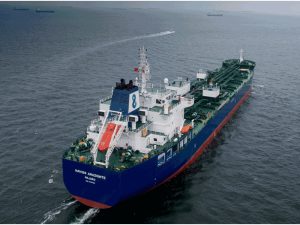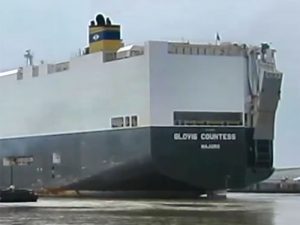
How are tankers valued?
The birth of VesselsValue was driven by timing and need. In 2008, the crisis in the financial market extended into shipping. The dry bulk sector and the containership sector were hit the hardest, and while tankers remained relatively buoyant, banks needed to assess their capital commitments against the value of the assets being financed and being used as collateral. However, in the depth of the crisis (2010 / 2011), ship brokers were telling clients they could not value the ships as there had been no recent sale or “last done” in ship broker speak. Richard Rivlin, a sale and purchase broker with 30 years’ experience, had long felt that an automatic valuation system could be built, which would produce valuations in any market, at any time. Luckily, his brother is a Professor of Mathematics, and together they designed and built such a system. It quickly became apparent that the highly detailed multi-level regression model was far too complex for normal spreadsheets, and a specialist modelling company was employed to develop the model.
The model is fed by two databases. One contains the features and specification of the ships arranged in a unique structure that allows the computational model high speed access. This database is researched and compiled by VesselsValue own team of 30 researchers and analysts on the Isle of Wight in the UK. The second database consists of sale and purchase transactions and charters. Both feed the mathematic model which is operated by a team of quantitative analysts. The aim was to produce an instant, accurate and always available online ship valuations for the banks and finance houses, that form the main customers of VesselsValue.
Tankers Valuation
According to VesselsValue, five factors make up a valuation:
- Type (VLCC, Suexmax and so on)
- Features (shipyard, hull, and so on)
- Age
- Cargo Capacity
- Freight Earnings
Each factor is broken down into further elements that are scored. As an asset, tankers are relatively straightforward, being highly commoditized, and standardized in terms of size ranges and specification. In part this is due to the international safety and pollution control legislation that has been forced on the tanker sector. This level of standardization makes VesselsValue task somewhat easier when it comes to scoring the factors, than offshore vessels, which have just been added to the system. In the case of tankers, there are around 140 scores. One of the most important scores is the shipyard. A vessel built in China is less desirable than one built in Japan. A well-published example is the one shown above. In November 2014, the New Century-built Supramax bulker ACS Diamond was sold for $10 million. The previous week, the slightly older Japanese-built pair of Supramaxes were sold for $15.5 million each. This was an implied discount of around 40% between Japan and China. However, the shipyard scoring goes into several levels of sophistication, including many ships the shipyard has built and when the last vessel was constructed.
This model is continually updated and recalibrated overnight to give the closest possible fit to the reported sales prices. It is the analysis of the sales that can produce the weightings required for different shipyards. These are applied to all shipyards, not just Chinese shipyards.
So far VesselsValue have performed over 1,000,000 valuations to date, about 400,000 a year and the number is increasing.
How Accurate is VesselsValue?
The split of VV customers are banks and finance houses, owners and other maritime industries such as lawyers, insurers and charterers – sophisticated market participants who insist on knowing the methodology behind our valuations. But ultimately they want to know how accurate are our valuations because this will affect their bottom line. Valuation accuracy is assessed as the difference between the price a vessel is sold at, and VV valuation on the day before the actual sales date. This is expressed as a % of valuations within a certain band of accuracy and shown in a chart form. The accuracy report is available on the website.
Tanker Valuations Development
According to the VesselsValue transactions database, between the start of 2012 and May 2016, a total value of $143 billion of tankers have been traded on the sale and purchase market. During that period the value of second-hand tankers has steadily increased, as can be seen from figure 1 (“VV Tanker Matrix”) below of the VV Tanker Matrix, expressed as USD / DWT.
During that period, the MR tanker has been the most frequently traded tanker type, both in terms of number of sales, and value (see figure 2 “Total Value by Type of Tankers Sold 2012 to Date”).
So far in 2016 (to 15 May 2016) 83 tankers with a total value of $1.4 billion, have been traded on the second-hand market, and again the MR tanker is the most popular (see figure 3 “Value of Tankers Sales Jan 2016 to YTD).
Interestingly, the average age of MR2 (Chemical / Product) tankers sold in the first five and half months of 2016 is only three years-old. Altogether 17 of these vessels were sold in this period, with eight tankers being sold by owners in the USA (these were not Jones Act vessels).
The majority of tankers and the largest value of tankers sold so far this year (2016) were constructed in South Korea, followed by Japan and China. As far as owners are concerned, the lead seller across all types of tankers was Chembulk Tankers, Scorpio Tankers and companies associated with the Navig8 group (see figure 4 “Top Ten Sellers of Tankers Ranked by Number of Vessels Sold”).
Recent Sales of Interest
The top three sellers have sold tankers for completely different reasons and strategy. In January 2016, Chembulk Tankers was sold by parent company Berlian Laju Tanker (BLT) to private equity investor Kohlberg Kravis Roberts (KKR). Chembulk Tankers is said to have a number of Contracts of Affreightments (CoAs) and the older tankers were surplus to requirement. This is part of the KKR growth strategy to rebuild the Chembulk Tankers fleet. KKR has also invested in a fund to invest in two Greek bank shipping portfolios.
The number two top seller, Scorpio Tankers, was a tactical, opportunistic sale. The purchaser, Bahri (formerly known as National Chemical Carriers of Saudi Arabia) is on something of a buying spree. Bahri has recently purchased two VLCCs from Tanker Investments in December 2015, for a reported $77.5 million. The five 2014-built MR2 tankers were sold en bloc for $167 million are trading in the UAE under Bahri CoAs.
The third most active seller, Navig8 Chemical Tankers, Inc., sold the four resales (the MR2 tankers are due for delivery in 2017) under a ten-year bareboat charter (with purchase option) for a reported $35 million each. This was an internal sale within the group, and part of a longer term strategy.


